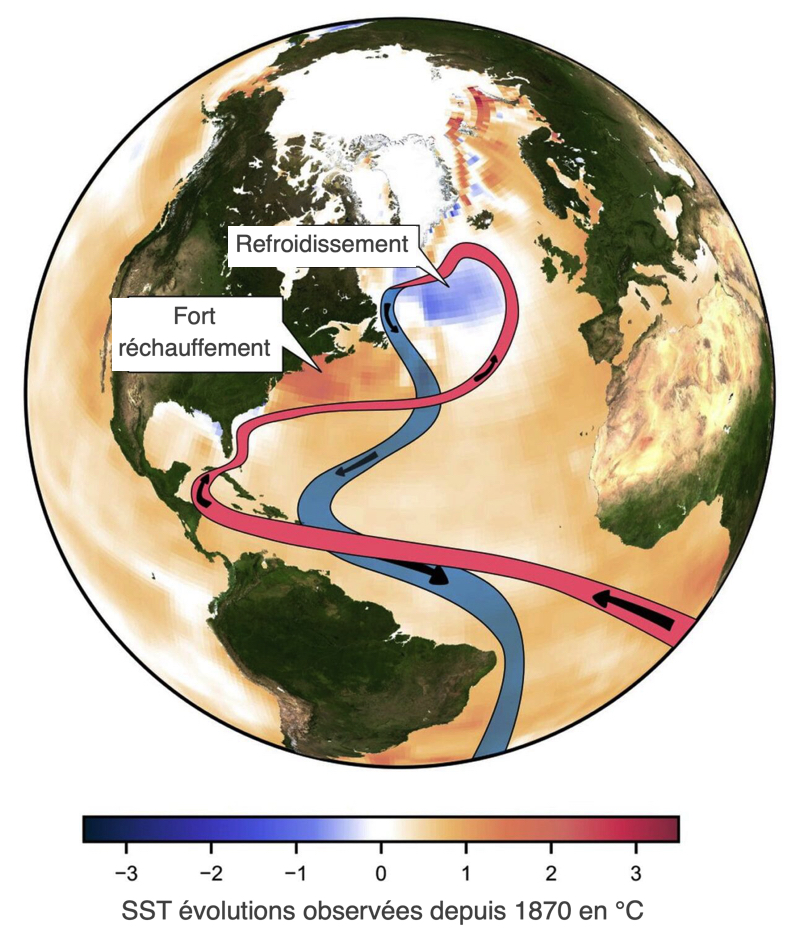No, these are not the catastrophic rantings of an inveterate collapsologist, but a very serious study reported by the climatologist Stefan Rahmstorf. I give here a French and freely adapted transcription.
The warm currents that reach Europe are now called by climatologists AMOC, in English the "Atlantic Meridional Overturning Circulation".
This circulation is composed of warm water from the Gulf of Mexico (Gulf Stream) which then reach the European coasts (North Atlantic Drift) before cooling down, turn north and dive deep between southern Greenland and Labrador.
By the effect of air masses circulating from west to east, by warming up in contact with its surface temperature, the AMOC plays a role in regulating the climate of Western European countries. However, current modelling indicates that the AMOC could experience disturbances resulting in colder winters and scorching summers, in a context of average warming of the Earth's atmosphere subject to strong local variations.
The scenario

Diagram of the AMOC, with warm waters flowing northwards on the surface, then plunging into the northern latitudes, to return as a cold deep current to the south. The background map shows the evolution of sea surface temperature since 1870 Based on ocean observations. This shows the imprint of the slowdown in the AMOC, a cold zone in the sub-polar North Atlantic and excessive warming north of the Gulf Stream. Figure adapted from Caesar et al. Nature 2018.
A recent study published in February 2024 (¹) by a group of Dutch scientists presents a new breakthrough by suggesting that a physics-based early warning signal shows that the AMOC is on a tipping point. The article is the result of a significant computational effort, based on the execution of a state-of-the-art climate model (²) over a modelled period of 4.400 years. It was necessary 6 months to run it on 1.024 cores at the National Supercomputing Centre of the Netherlands.
This study confirms that the AMOC has a tipping point beyond which it breaks down if the North Atlantic Ocean is diluted with fresh water by increasing rainfall, river runoff and arctic meltwater, thus reducing its salinity and density. It confirms, using observational data, that the North Atlantic is getting closer to this tipping point. The question is to know how far away is the tipping point.
What implications? ?
The new study confirms concerns expressed in the past that climate models have systematically overestimated the stability of the AMOC. Regarding the crucial transport of freshwater from the AMOC in models, it points out that most of the models are wrong. They even reversed the signal of this important diagnosis, which determines whether the salinity of the Atlantic is stabilized or destabilized, and this model bias is one of the main reasons why the IPCC has so far underestimated the risk of an AMOC collapse by relying on these biased climate models.
The study also provides more detailed and higher-resolution simulations of the effects of an AMOC collapse on the climate, although they are considered in isolation and not combined with the effects of CO2-induced global warming. It shows that Northern Europe, from Great Britain to Scandinavia, would be devastating, such as a cooling of winter temperatures from 10° to 30 °C occuring within a century, leading to a completely different climate in the space of one or two decades, in line with known paleoclimatic data regarding abrupt changes in ocean circulation. They also reveal major shifts in tropical rainfall belts. These effects of an AMOC collapse have been known for a long time, but had not yet been demonstrated by a climate model of such quality.

Temperature evolution during an AMOC collapse (model simulated over a century since 1750 down to 1850). By van Westen and al. 2024
How long will it take ?
Given the consequences, the risk of the AMOC collapsing must be avoided at all costs. The question is not whether we are sure that this will happen, but whether we should rule out this risk with a probability of 99,9 %. Once we receive a clear warning signal, it will be too late to do anything, given the inertia of the system (³).
Such an experiment is not a projection into the future. Rather, it aims to draw the equilibrium stability curve. In order to plot the equilibrium response, the freshwater input must be added very slowly, which explains why this experiment required a lot of computer time. Once the model tipping point has been found in this way, it has been used to identify precursors that could warn us before we reach the tipping point, so-called " early warning signals ”. The scientists then turned to the reanalysis data (observation-based products) to check for an early warning signal. It was on the basis of this data that they concluded that the AMOC was "on tipping course".
The Dutch research group has proposed a new type of early warning signal, physics-based and observable. It uses the transport of freshwater by the AMOC at the entrance of the South Atlantic as a diagnostic, across the latitude of the southern tip of Africa. They don't provide an estimation of a particular date period for reaching the tipping point, as more observations of the ocean circulation at this latitude will be needed to achieve this. But they note about a recent study (⁴) : "The prediction that the tipping will happen as soon as mid-century (2025-2095 with a confidence range of 95 %) could be accurate".
In other words, it is the observation data from the South Atlantic that suggest that the AMOC is tipping over. Not the simulation of the model, which is only there to better understand which early warning signals are working, and why.
–––
To learn more about this fascinating subject : a paper (in English) published in the journal Nature in April 2018.
–––
(¹) Physics-based early warning signal shows that AMOC is on tipping course
(²) The model CESM with a horizontal resolution of 1° for the ocean/sea ice component and 2° for the atmosphere/land component
(³) The AMOC: tipping this century, or not?
(⁴) Warning of a forthcoming collapse of the Atlantic meridional overturning circulation
–––




Digging, but since the time that this subject has come back "out the window" and since this theory is far from being inept, I suggest to keep an eye on. Unfortunately, like all these theories and changes happen in a slow time for a human, I mean that 2095, in our little heads it's in a long time, We are not more alarmed than that. Besides, we must not be alarmed, Above all, we must admit and understand. No doubt it will take a little more time for people to admit that climate change is much too rapid to be trivial. Wait and see.
By the way, Thank you for your blog, who has already informed me well about effective technical solutions.
Bonjour,
"Catastrophic fantasies of an inveterate collapsologist"
This is a delight to the eye and the ear.
Thank you for this tasty vocabulary